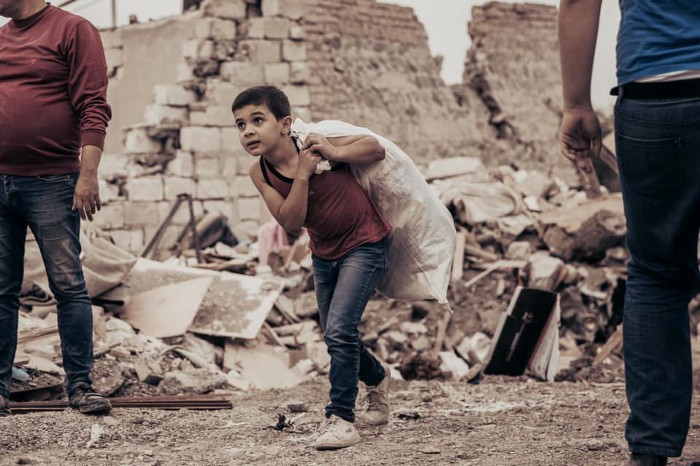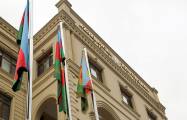by Dan Mason
Decades of bitter rivalry between Azerbaijan and Armenia over Nagorno-Karabakh have exploded into all-out war. But what drives the feelings of ordinary Azerbaijanis towards the conflict? Journalism trainer Dan Mason has worked extensively in Azerbaijan and gives this personal view.
The steel thread that unites every Azerbaijani
The first time I saw the cluster of grey towers in the far distance, I thought it might be an old Soviet factory complex. But as our car drew closer I saw apartment blocks, built miles from anywhere on a featureless plain. A few children played with a ball among scattered parked cars. Washing fluttered from concrete balconies. Otherwise, the place looked deserted.
“It’s a settlement for IDPs [internally displaced persons] from Karabakh,” said my friend Elmir as we drove on towards Barda. “There are several in this area.”
I’ve seen them dotted around Azerbaijan, from high-rise developments the size of towns to isolated villages, built to cope with the tidal wave of Azerbaijanis who fled from the war with Armenia in the early 1990s. Many spent years in sprawling tented settlements near the border with Iran (the last closed in 2008). I have heard their stories often, of being wrenched from a settled family life to live off handouts, surrounded by poverty and poor health.
Fast forward four years. It’s almost a month since war erupted with Armenia and, despite the unreliable internet connection, I’m in daily contact with Azerbaijani friends and journalists. Two messages from the last few hours …
The first from Elmir, my friend in the car: “Excuse me, I wrote you a late reply. My uncle died as a result of the Armenian shelling of the villages of Aghjabadi. My head was involved in his funeral. My uncle died as a result of a rocket fired by Armenians at a settlement. He was middle-aged. He had four children.”
The second from Zaka in Baku: “The good news is that my homeland Zanglian was liberated from Armenian occupation. Can you imagine after 27 years my family and I will have the chance to visit our motherland where I was born. This is a great feeling and I hope to host you in my Zanglian.”
In Azerbaijan right now, each hour is transforming lives.
Over the past ten years, I have led training projects the length and breath of Azerbaijan. Without exception, in every group I have worked with, at least one, two or more people are from Karabakh or the occupied regions. They all tell of a life shaped by loss and injustice.
This loss of homeland, dignity and opportunity is a steel thread that binds Azerbaijanis like nothing else. No single word in Azerbaijani is charged with so much pain and emotion as Karabakh.
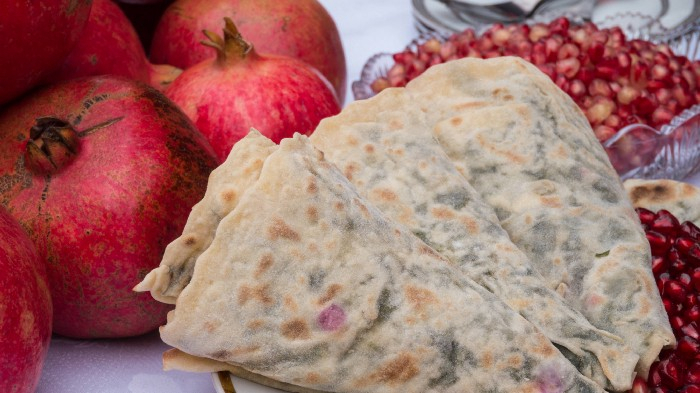
Qutab (pancakes) with nar (pomegranate), served at the annual Nar Festival in Göychay, Azerbaijan. Image: DM
Aggressors or defenders? Inside the Azerbaijani DNA
You have to scratch the surface to love Azerbaijan. I have and I do. Half the country’s ten million citizens live in Baku, where elegant architecture, seaside boulevard and cafe lifestyle clash with an outer sprawl of gritty high-rise apartments that define the city’s Soviet-era expansion.
The other half is scattered across the largely agricultural regions from the forested foothills of the Caucasus to the dusty Iranian border, where farmers grow the national fruit of nar (pomegranates), shepherds tend their flocks, and local women welcome travellers at roadside cafes selling fresh-made qutab (pancakes) sprinkled with sumac, and tea from wood-fired samovars.
In Baku shops, the service can be somewhat abrupt (maybe Soviet habits die hard), but to be invited to the home of an Azerbaijani family is to experience hospitality you will never forget. Family is everything. Babies’ birthdays are celebrated every month. Gifts between friends abound. If you don’t like cake, you’ll struggle in Azerbaijan.
There is something both proud and fragile about Azerbaijan. Emotions run silent and deep and burst out with surprising force. Tradition rules, both comforting and restrictive. On first meeting, you might spot suspicion in the eyes of an Azerbajani, but when it turns to friendship, it’s for life.
The suspicion is justified. Surrounded by the juggernauts of modern-day Russia, Turkey and Iran, here is the pivot around which the millstone of imperial ambition has been grinding for millennia. In the firing line from all sides, the lands of the Caucasus have been repeatedly fought over, trampled on and carved up. Even the British had a go at running it in 1919.
The same mill helped produce an astonishing culture. Speak to a taxi driver in Baku and you are just as likely to find a poet as an engineer earning a few extra Manat. The Baku Jazz Festival celebrates Azerbaijan’s own fusion style. The oldest dated carpet in the world, displayed at London’s Victoria & Albert museum, was weaved by Azerbaijani hands (in what is now Iran, thanks to a treaty with Russia that sliced off southern Azerbaijan).
Self-reliance, survival and creativity are in the DNA of Azerbaijan. Aggressive by nature? Not the Azerbaijan I know.
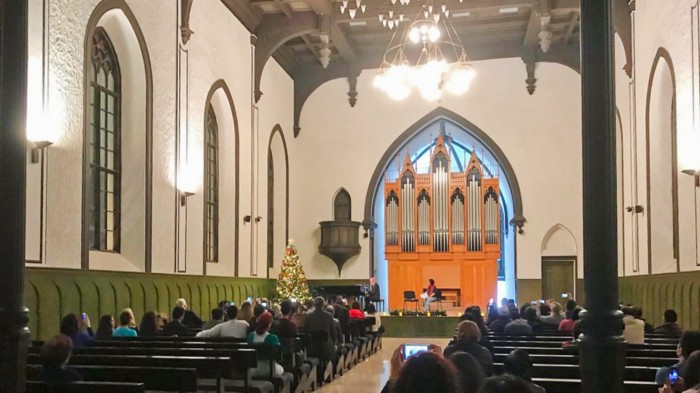
The German Lutheran Church in Baku is a popular concert venue as well as a place of worship
It’s about religion, right? Wrong.
Some commentators have tried to stir up a religious dimension to the war between Christian Armenia and majority-Muslim Azerbaijan. Don’t believe it.
No visitor to Azerbaijan would dispute its boast to be a secular Muslim country. There is a district of red-roofed houses in Quba some call the Jerusalem of the Caucasus, reportedly the largest Jewish settlement outside Israel. I have friends who attend the Catholic Church and I love the elegant simplicity of the German Lutheran Church in Baku. Freedom of worship is written into the constitution. The Armenian church in the centre of Baku is closed, but unharmed.
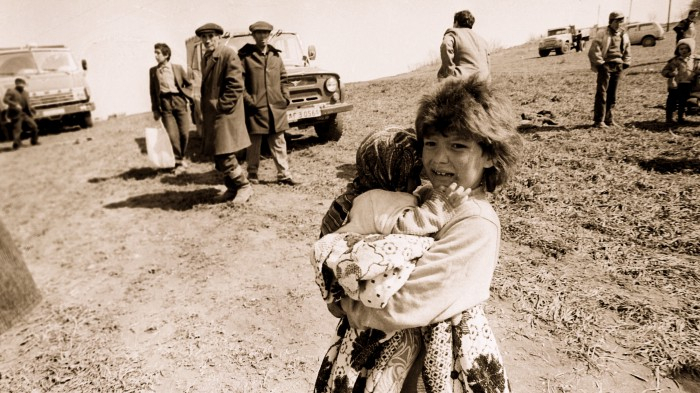
An Azerbaijani girl carries a baby during the escape from fighting in the Kalbajar region during the early 1990s. Image: Ilgar Jafarov
Independence … and the road to bloody war
Azerbaijan became (again) an independent country just 29 years ago. It’s hard to imagine what it must be like to claim back your own country after seven decades of Soviet occupation and oppression, but I’m told it was a time of hope, fear and chaos.
In Britain, the collapse of the Soviet Union conjures up TV images of students knocking souvenir chunks from the Berlin Wall while mute East German guards look on. I don’t recall much about the citizens of the Caucasus facing Russian tanks and bullets.
In Azerbaijan and elsewhere, independence was paid for in blood. The black marble headstones along Baku’s Avenue of Martyrs is a heart-wrenching tribute to the hundreds of unarmed protesters killed on the same day, January 20, 1990, while calling for the freedom they did not live to see.
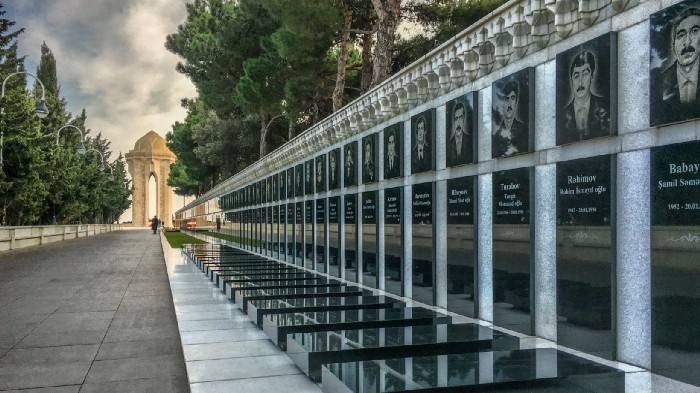
The Avenue of Martyrs: A sombre tribute to those who died for independence on the same day in 1990. Image: DM
Emerging independence brought economic meltdown. Inflation soared. Schools wanted to switch to teaching in Azerbaijani, but textbooks were in Russian. Civil war sparked by pro-Russian radicals was averted.
Into the maelstrom came separatist demands from the ethnic Armenian majority of Nagorno-Karabakh. Initial protests led to to violent clashes and deaths in both Karabakh and Azerbaijan, then all-out war with Armenia, spanning six years to the peak of the fighting in 1994. During that time, it is estimated around 30,000 soldiers and civilians died on both sides.
On February 26 each year Azerbaijan stops to remember the Khojaly Massacre in 1992. It is said that 613 Azerbaijanis were murdered and mutilated, including 169 women and children, while trying to escape the siege by Armenian forces. The worst atrocity of the war, it is a genocide that burns the soul of every Azerbaijani.
At least 860,000 Azerbaijanis escaped from Nagorno-Karabakh, seven surrounding regions and Armenia itself, according to the UN (one in eight of the population of Azerbaijan). Later government figures put the number closer to one million.
IDPs and refugees poured eastward with nothing except their lives. It would be decades before many had somewhere they could call home. At the same time, the UN estimates around 360,000 ethnic Armenians fled Azerbaijan. Reports say around 36,000 made their way to Nagorno-Karabakh.
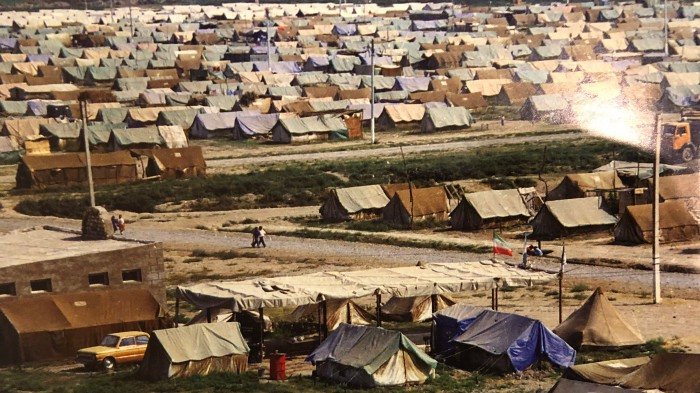
A sea of tents erected for Azerbaijani IDPs and refugees fleeing the war with Armenia. For many the tents would be home for years. Image: UNHCR/Flickr
Both sides signed a Russian-brokered ceasefire in 1994. Its stated objective was a lasting agreement that included: “withdrawal of troops from occupied territories and … return of refugees.” No agreement followed.
Hopes of a peaceful solution have rested with the OSCE Minsk mediation group, set up in 1992 and chaired jointly by France, Russia and the United States. All attempts have failed.
Four United Nations resolutions have called for the “withdrawal of occupying forces from … occupied areas of the Azerbaijani Republic” with no result.
Until now, Armenia has remained, directly or indirectly, in control of 20 per cent of Azerbaijan territory covered by the self-declared Republic of Artsakh. A republic no major nation recognises.
The hashtag #KarabakhIsAzerbaijan states a simple fact.
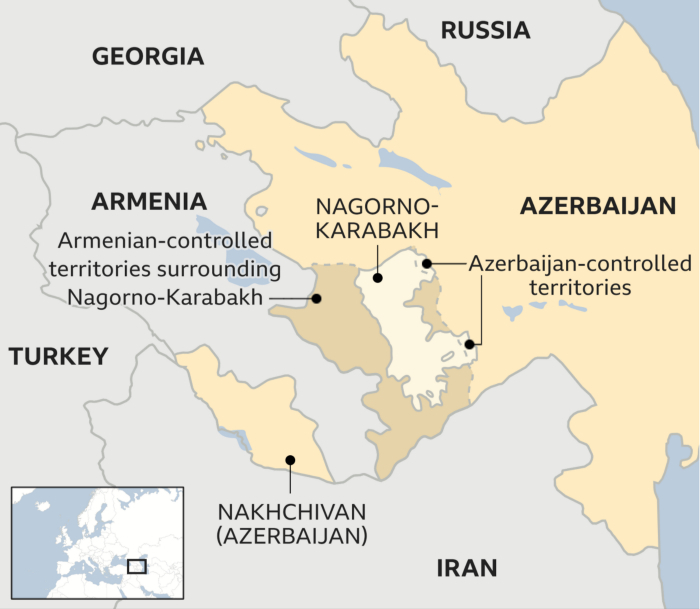
Map showing the areas controlled or supported by Armenia until the gains made by Azerbaijan forces after September 27. Source: BBC
Politics, power and people
Today, as throughout history, the fate of ordinary people in both Azerbaijan and Armenia continues to play out in the shadow of international politics.
Even the decision by Stalin to make Nagorno-Karabakh a land-locked enclave within Azerbaijan was conflict by design. The map makes little sense until you factor in his divide-and-rule policy to create areas of mixed ethnicities that depended for survival on Moscow.
So why go to war now? Above the layers of historical friction lie Turkey’s growing ambition, the reticence of Iran, the allegiance of Israel and Pakistan, Covid-19, and, not forgetting oil, the expansion of Azerbaijan’s gas exports running through pipelines close to Karabakh. Russia’s relationship with Azerbaijan and Armenia is, as ever, critical.
But the spark could prove to be the dramatic regime change in Armenia two years ago and rise of prime minister Nikol Pashinyan on a wave of nationalism. Nothing could have been designed to provoke Azerbaijan, or fly in the face of international diplomacy, more than Pashinyan’s visit to Karabakh last year when he declared: “Artsakh is Armenia, and that’s it.”
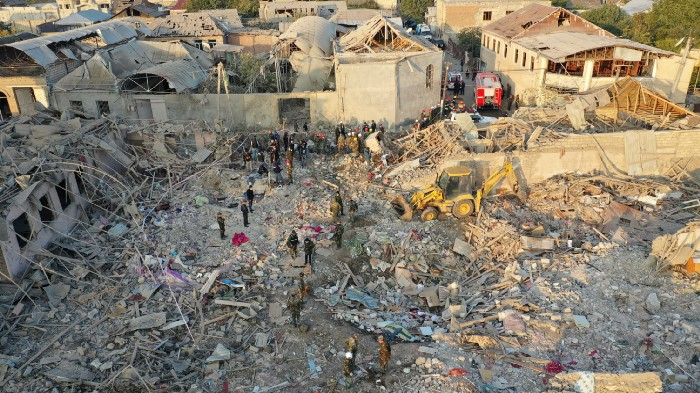
Emergency teams at work in the rubble of the latest rocket attack on Ganja, killing 13 and wounding 52
The final word: What Azerbaijanis want
No-one I know wants war, but there’s a feeling this had to happen, sooner or later. Mothers have continued to wave goodbye to their sons entering national service, knowing they could become the target for a sniper’s bullet, one of the 30 or so soldiers on both sides to die on the ‘line of contact’ each year.
After three decades of frustration and dashed hopes, people see that nothing has changed. Enough is enough, I hear. We want to go home.
Today there is joy that historic lands have been liberated. But grief and anger over the indiscriminate bombing of the second city Ganja (three times) and other civilian targets nowhere near the front line. Armenia denies responsibility. Where is the UN now?, people ask.
Such attacks (13 civilians died and 52 were injured in the latest Ganja explosions) only harden the resolve to see this through to the bitter end.
In many ways Azerbaijan is fighting to get back to the start point for negotiations, a place mediators have failed to reach for decades. ‘We are fighting on our own land for our own homes,’ is the cry.
These are the voices of the #1MillionAzerbaijaniRefugees.
I haven’t been to Karabakh and I haven’t trained in Armenia. But I work with journalists on both sides of conflict and I know that when peace comes, it will rest not only on compromise and respect for international law, but ultimately on the will of Azerbaijani and Armenian citizens to live and work together. They’ve proved it before. I believe they can do it again.
The Azerbaijan government has not released military casualty figures, although estimates of combined military and civilian deaths so far range from under 1,000 on each side to a claim by President Putin that the total toll of the war is “nearing 5,000”.
I asked a friend how she felt about that.
“We know soldiers and civilians are dying. On both sides. We hate it and we don’t want it, but nearly 30 years have gone by without a solution. We don’t have a choice,” she said.
“There’s a feeling that if we don’t die for this land now, our children will have to die for it, and their children.”
Dan Mason is an international journalism and media project trainer.
The original article was published on Medium.com.
More about: Azerbaijan Armenia








